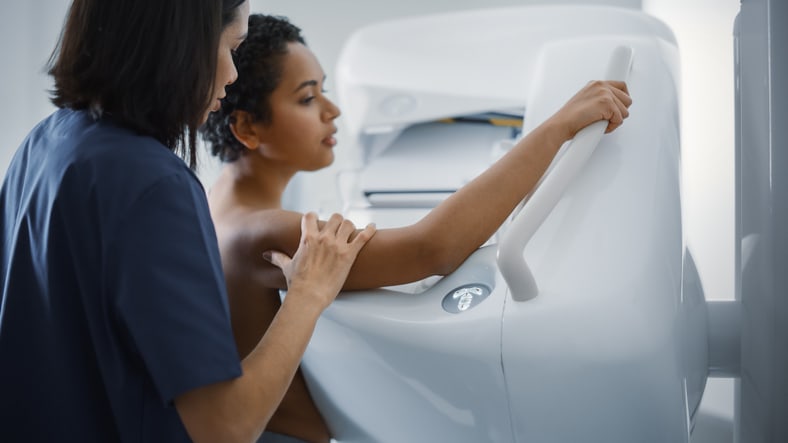
[3 min read]
In this article:
- New breast cancer screening guidelines recommend that screenings begin at age 40 and continue every other year until age 74.
- A rising incidence of breast cancer in younger women prompted the guidelines change.
- A Swedish expert explains the changes and answers some common questions about them.
The U.S. Preventive Services Task Force (USPSTF) has once again updated their screening recommendations for breast cancer. In 2016, the USPSTF recommended breast cancer screening start at age 50 and continue every other year until age 74. The group also recommended that patients in their 40s who wanted screening should discuss their risk with their doctor.
In May, new guidelines from the USPSTF were published in the Journal of the American Medical Association (JAMA), recommending that breast cancer screening start at age 40 and continue every other year until age 74 to better serve younger women. Statistics collected between 2015 and 2019, show a 2% increase in breast cancer diagnoses per year among women in their 40s.
To learn more about the latest change in breast cancer screening guidelines, we spoke to Michaela Tsai, M.D., medical director of breast oncology at Swedish.
“In the past two decades, we have seen a significant rise in the incidence of breast cancer in young women,” says Dr. Tsai. “There are likely many reasons for this increase, although more research is needed to better define the underlying causes.”
Does this mean that the guidelines are now the official standard?
The latest recommendations from the USPSTF remain just that – recommendations. Many other organizations and physician practices do look to the USPSTF for guidance and adopt their recommendations as guidelines.
Why are we seeing these rising rates of breast cancer among younger women?
The main reason the recommendations changed was due to the rising rates of breast cancer in younger women, especially younger women of color. Previously, the recommendation was for women aged 40-50 to discuss screening with their primary care provider. Now, it is recommended every other year for all women.
There is no one reason why the rates are rising in young women. It is a combination of many factors, some known, and some yet to be discovered. We do know that more women are using hormonal contraceptives and hormone replacement therapy. They are using these agents at a younger age and for longer periods of time.
Many women are delaying pregnancy and childbirth until they have completed their education and established their careers. A later age at first childbirth or not giving birth are both risk factors. There are some lifestyle factors that likely contribute such as increased alcohol consumption. Alcohol is now classified as a carcinogen in many countries. Obesity is another well-known risk factor. More body fat translates to more estrogen and a higher risk of breast cancer, especially as women age. There may well be other environmental factors that have not yet been specifically identified.
The American Cancer Society (ACS) has aligned with these new guidelines. Why did they previously differ?
The ACS has favored screening at a younger age and more frequently. Now, the USPSTF is in alignment with the ACS.
Should I ask my physician if they follow these guidelines or those of an organization with a differing opinion?
One should always discuss individualized recommendations with their health care provider. Recommendations may differ based on individual risk factors.
“Breast cancer treatments continue to improve. Advances in molecular testing have led to more targeted and less toxic treatments,” adds Dr. Tsai. “But detecting cancer earlier through screening is critical in reducing the number of deaths from breast cancer.”
Learn more and find a physician or advanced care pratitioner (ACP)
If you or a loved one have questions about breast cancer diagnosis, treatment or care, the experts at Swedish Cancer Institute are here for you. We can accommodate both in-person and virtual visits.
Whether you require an in-person visit or want to consult a doctor virtually, you have options. Contact Swedish Primary Care to schedule an appointment with a primary care provider. You can also connect virtually with your provider to review your symptoms, provide instruction and follow up as needed. And with Swedish ExpressCare Virtual you can receive treatment in minutes for common conditions such as colds, flu, urinary tract infections, and more. You can use our provider directory to find a specialist or primary care physician near you.
Information for patients and visitors
Additional resources
Mastectomy surgeries offer patients single-procedure reconstruction and reduced loss of sensation
After mastectomy, patients find a healing, helping hand at Swedish Plastics and Aesthetics
Talk With A Doc: Let's Talk Breast Cancer: Beyond the Pink Ribbon | Apple Podcasts
At Swedish, the very best care for every woman at every stage of life | KING 5
This information is not intended as a substitute for professional medical care. Always follow your health care professional’s instructions.
Providence Swedish experts in the media
Follow us on Facebook, Instagram and X.
About the Author
More Content by Swedish Cancer Team























